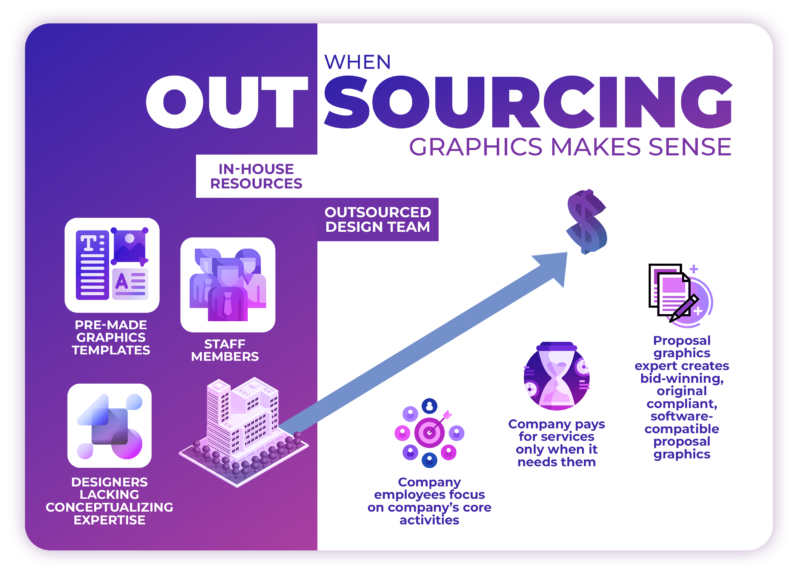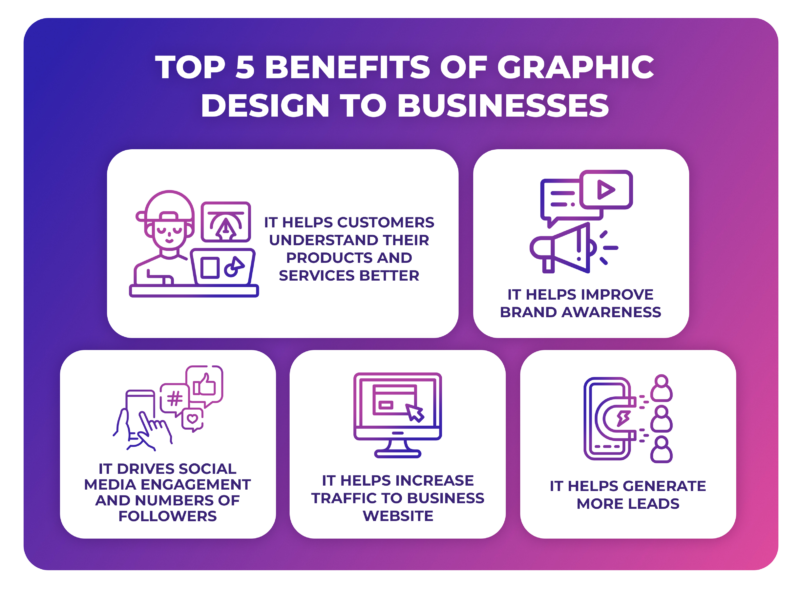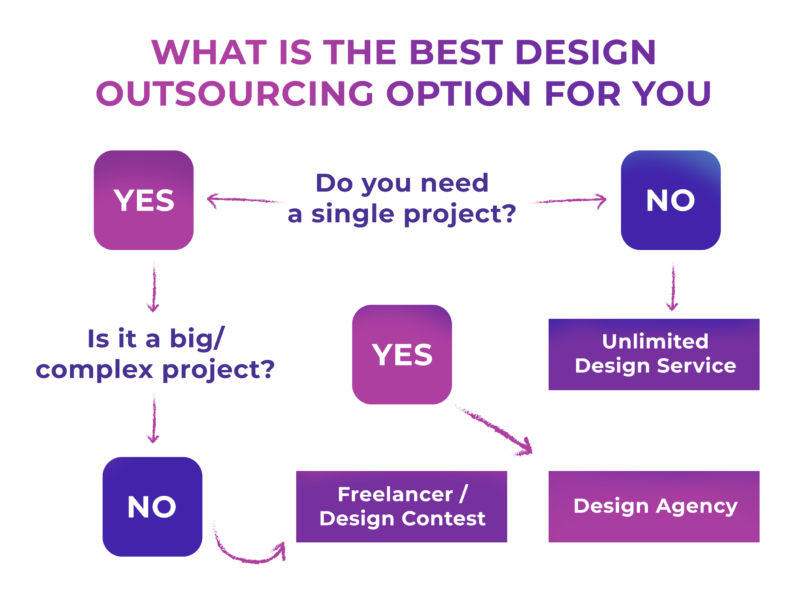Outsourcing graphic design is the strategy wherein businesses engage freelance designers or specialized firms, frequently from international locations, to provide graphic design services. This is often an alternative to retaining an in-house designer or team. Graphic designers from various corners of the world can bring a fresh perspective and specialized skills to a project.

This article is curated as a comprehensive guide for companies and individuals aiming to delve into the nuances of outsourcing their graphic design needs. One can achieve outstanding outcomes while sidestepping potential pitfalls by understanding the advantages and methodologies of working with an external graphic designer.
Benefits of Outsourcing Graphic Design

Cost Savings
By effectively venturing into the expansive global talent pools to outsource graphic design, companies have the advantage of discovering skilled designers capable of delivering unlimited graphic design service. These designers often come at a fraction of the price compared to local alternatives. This strategy not only results in substantial budget savings for graphic design projects but also enriches the design process by bringing together a diverse design team from various backgrounds.
Improved Customer Satisfaction
With experienced designers proficient in a myriad of styles and genres, including logo design, businesses can outsource graphic design work to produce high-quality designs that strike a chord with their target audience. Rather than solely relying on an in-house web design team, embracing unlimited graphic design services allows firms to tap into the expertise of full-time graphic designers from various backgrounds. This diverse approach undoubtedly leads to an enhancement in customer satisfaction.
Access to a Larger Pool of Talent
Outsourcing provides companies with the opportunity to tap into an extensive and varied pool of talented designers from various corners of the globe. This diversity ensures that businesses can find the ideal match in terms of expertise and style for any given project.ds.
Improved efficiency
External designers, especially those spread across different time zones, have the capability to operate virtually around the clock. This continuous workflow greatly accelerates the project’s turnaround times. With design tasks efficiently handled by these professionals, businesses can redirect their attention and resources, concentrating more on their primary functions and core operations, ensuring overall growth and productivity.
Steps for Outsourcing Graphic Design Effectively
Define Your Customer Service Needs
Before diving into the world of outsourcing, it’s imperative for businesses and individuals to conduct a thorough assessment of their needs. This means precisely determining your design requirements, comprehensively outlining the project scope, and envisioning the desired outcomes you aim to achieve. Establishing these foundational elements upfront not only sets clear expectations but also ensures that the outsourcing journey progresses smoothly and aligns with the intended objectives.
Research Outsourcing Options
When seeking top-notch designers or reputable design firms that align with your specific requirements, it’s beneficial to delve into popular platforms known for housing professional talent. Websites such as Behance, Dribbble, and Upwork serve as extensive repositories of portfolios and profiles. By navigating through these platforms, you can review work samples, read client reviews, and engage directly with potential candidates, ensuring that you find the perfect fit that resonates with your project’s vision and needs.
Develop a Clear Communication Plan
In the realm of outsourcing, fostering mutual understanding is paramount to the success of any project. To achieve this harmony, it’s essential to establish and articulate clear guidelines that outline the expectations and standards required. Moreover, setting definite deadlines ensures that both parties are aligned in terms of timeframes, promoting efficiency. Additionally, designating specific channels of communication – whether that be email, messaging apps, or regular meetings – facilitates smooth interactions and quick resolutions, ultimately leading to a more streamlined and effective collaboration.
Implement and Monitor the Outsourcing Process
After initiating a partnership with a designer or firm, it’s crucial not to become complacent. Active involvement is the key to realizing your vision. This means consistently reviewing the progress of the project at various stages, providing timely feedback, and offering constructive criticism when necessary. Regular check-ins and open dialogue ensure that the work remains aligned with the set objectives. By maintaining this level of engagement, you enhance the likelihood of achieving the results you envisioned, while also building a strong, collaborative relationship with your outsourced team.
Factors to Consider When Outsourcing Graphic Design
Quality of Services
When considering a potential partnership with a designer, it’s vital to undertake a thorough evaluation of their expertise and reliability. Begin by examining their portfolios in detail, which showcase their range, style, and the depth of their work. Furthermore, requesting case studies can provide insights into the designer’s approach to various projects and the solutions they’ve crafted in response to different challenges.
Additionally, asking for references or testimonials from past clients can offer a firsthand account of their experiences, helping you gauge the quality, professionalism, and consistency of the designer’s work. This comprehensive assessment ensures you’re making an informed decision aligned with your project’s needs.
Availability and accessibility
When collaborating with a designer or a firm, especially one possibly located in a different time zone, it’s imperative to ascertain their availability aligns with your working hours. This ensures that real-time discussions, feedback sessions, or urgent alterations can be efficiently managed without unnecessary delays. Additionally, confirming that the designer is accessible through your preferred communication channels, emails, video conferences, messaging apps, or phone calls, can significantly smoothen the collaborative process.
Establishing these parameters at the onset lays the foundation for a more streamlined and effective working relationship, minimizing potential misunderstandings and fostering productivity.
Cost
While one of the primary advantages of outsourcing is the potential for cost savings, it’s imperative not to compromise on the quality of the output solely for financial reasons. The allure of affordability can sometimes overshadow the importance of excellence in work. Therefore, while it’s beneficial to seek cost-effective solutions, it’s equally crucial to ensure that the quality of work isn’t sacrificed in the pursuit of a lower price point. In essence, striking a harmonious balance between cost-effectiveness and high-quality output will yield the most satisfactory and sustainable results in the long run.
Cultural Compatibility
In the realm of design, understanding the target audience is paramount to creating impactful and resonant work. It’s highly advantageous, if not essential, for the designer to have a grasp of the cultural nuances, traditions, and preferences of your target demographic. By having this deeper insight, the designer can craft visuals and messages that not only appeal aesthetically but also resonate emotionally and contextually with the intended audience. Such a culturally sensitive approach ensures that the designs are not only visually pleasing but also culturally appropriate and effective in conveying the intended message.
Tips for Successful Graphic Design
Foster Open and Clear Communication
Maintaining a consistent line of communication with your outsourced team is paramount for the success of any project. It’s crucial to regularly update and engage in consultations with them. This continuous interaction helps in addressing any emerging issues promptly, sharing evolving project requirements, and ensuring that both parties remain on the same page throughout the duration of the collaboration. By fostering this active and open dialogue, you can ensure that the project remains aligned with its initial objectives, while also building a sense of partnership and mutual understanding.
Maintain a consistent brand voice
Aesthetics and visual trends may evolve and shift over time. However, amidst these changing visual landscapes, it’s imperative to anchor your projects in a constant: your brand’s core message. While experimenting with various design elements can bring freshness and appeal, the essence and values your brand stands for should remain unwavering. This consistent core message serves as a foundation, ensuring that your audience can always identify and resonate with your brand’s unique voice and identity regardless of the design trends you adapt to.
Use Technology to Your Advantage
Having the right tools at your disposal can significantly enhance project management and streamline communication. Platforms like Trello offer an organized space where tasks can be itemized, tracked, and monitored, facilitating a clear view of project progression. On the other hand, Slack serves as a dynamic communication hub, allowing for real-time conversations, file sharing, and instant feedback. Leveraging these tools ensures that everyone remains on the same page and fosters a collaborative environment where tasks are efficiently managed, and communication flows seamlessly, ultimately driving project success.
Continuously evaluate and improve the outsourcing process
In the pursuit of excellence, it’s essential to adopt a proactive approach toward evaluating project outcomes. Regularly reviewing the results and gathering feedback from internal stakeholders and the target audience offers invaluable insights. These insights highlight areas of strength and pinpoint avenues for enhancement. By consistently assessing these outcomes and being receptive to feedback, businesses can foster a culture of continual improvement. This iterative process ensures that the work remains aligned with the set objectives, evolves with changing needs, and consistently strives for higher standards of quality and effectiveness.
Potential Challenges of Outsourcing Graphic Design and How to Overcome Them
Language Barriers
When engaging with designers, especially from different cultural or linguistic backgrounds, effective communication becomes paramount. It’s beneficial to select designers who have a strong grasp of your preferred language to ensure clarity and mutual understanding throughout the collaboration. This proficiency helps in reducing misinterpretations and streamlines the feedback process.
However, in situations where there might be minor language barriers, leveraging modern translation tools can be invaluable. These tools can efficiently bridge communication gaps, ensuring that both parties understand each other’s perspectives and requirements, leading to a more harmonious and productive working relationship.
Time Differences
In the world of global collaborations, navigating through differing time zones becomes a prevalent challenge. To maintain a smooth workflow and open communication channels, it’s essential to strategically schedule regular updates. Ideally, these check-ins should be planned during overlapping working hours, ensuring that both parties are available and can engage in real-time discussions. In situations where overlapping hours might be limited, adjusting project timelines and setting clear expectations regarding response times can be beneficial. By making these adjustments and planning proactively, businesses can ensure that geographical differences don’t hinder the efficiency or productivity of the collaboration.
Maintaining Control Over the Customer Experience

Preserving the integrity and consistency of a brand’s identity is paramount. To achieve this, it’s essential to provide your designer or team with comprehensive brand guidelines. These guidelines, encompassing elements from color palettes to typography, offer a clear roadmap on the aesthetic and tonal expectations of the brand. By regularly reviewing the outputs in the context of these guidelines, businesses can ensure that every piece of content or design meets quality standards and resonates with the brand’s established identity. This meticulous attention to detail and consistent oversight guarantees that your brand’s voice remains consistent across various platforms and mediums.
Outsourcing graphic design has emerged as a transformative approach for businesses worldwide, offering a trifecta of benefits. Firstly, it paves the way for notable cost savings, allowing companies to allocate resources more efficiently. Secondly, by tapping into specialized expertise, businesses often witness enhanced customer satisfaction as designs resonate more profoundly with the target audience. Lastly, the doors to a sprawling global talent pool open, bringing in diverse perspectives and skills. Yet, while these benefits are palpable, the true key to maximizing the potential of outsourcing lies in meticulous navigation. Ensuring clear communication, combined with a well-thought-out strategic approach, becomes paramount in harnessing the advantages of outsourcing graphic design.
Final Thoughts on Making a Successful Outsourcing Decision
With its vast array of benefits, outsourcing has revolutionized how businesses operate in a globalized world. However, the true potential of outsourcing is unlocked when companies combine this approach with a rigorous commitment to due diligence. This entails carefully vetting potential partners, establishing open communication channels, and setting clear guidelines and expectations. Moreover, amidst the allure of accessing global talent and potentially cost-effective solutions, it’s imperative not to lose sight of the core essence of your brand. While embracing the richness and diversity of the international design community, businesses should always ensure that their brand’s unique voice and overarching vision remain at the forefront of every decision and collaboration.



Leave A Comment
You must be logged in to post a comment.